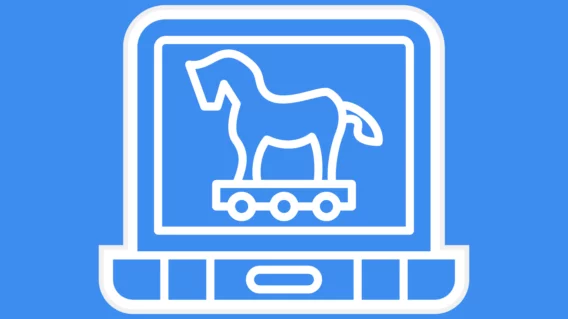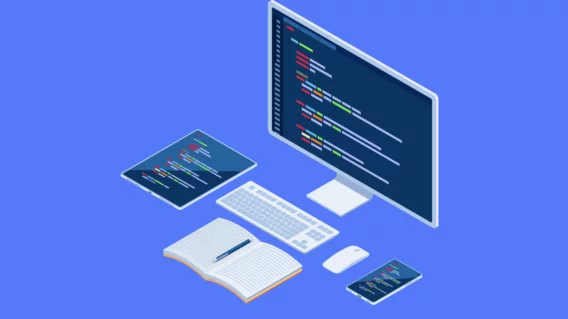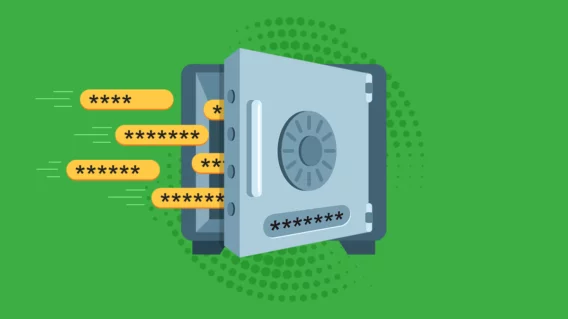The Trojan Horse Virus: Understanding the Silent Threat

The trojan horse virus is a significant cybersecurity threat. Now that businesses have moved their operations online, the risks from these hidden threats are growing. Many users and enterprises don’t detect the presence of a trojan until after substantial damage occurs.
In this in-depth exploration, we’ll navigate the intricate world of trojan viruses, detailing their modus operandi, their diverse variants, and the essential strategies businesses can employ to guard against them.
What is a Trojan Horse?
The term “Trojan Horse” in cybersecurity refers to malicious software or files disguised as legitimate. This deceptive tool is designed to mislead users about its true intent and thereby gain unauthorized access to their systems.
Etymology: Historical Context
Drawing its name from the famous Greek strategy, the “Trojan Horse” story revolves around Greek warriors concealed within a large wooden statue. Presented as a token of surrender, the Trojans unknowingly welcomed this “gift” into their fortified city. Later, the hidden warriors emerged, facilitating the Greek’s victory.
In the cyber context, trojan malware also deceives its way into systems. While the original Trojan Horse smuggled Greek warriors without detection, cyber trojans facilitate undetected malware that can spread once it has access to the system.
Operational Deception
Trojans present themselves in a myriad of ways: camouflaged within seemingly innocuous email attachments, masked as software patches, or even embedded within attractive applications. These disguises cater to users’ behaviors and preferences, enticing them to inadvertently initiate the trojan’s execution, and consequently, endangering their systems.
How Do Trojan Viruses Work?
Trojan viruses are the quintessential digital double agents, appearing harmless but possessing a harmful intent. By understanding their modus operandi, we can better defend against these cyber threats.
Silent Infiltration
Trojans can begin their clandestine operations once they enter the system; they can also remain dormant at first. Distinct from other types of malware, which might result in noticeable glitches or system slowdowns, trojans are designed to be discreet. They avoid any significant disruptions or overt activities that might alert users to their presence.
This stealth approach ensures their malicious tasks go undetected for prolonged periods, granting them ample time to achieve their objectives.
Diverse Malicious Activities
The utility of a trojan is largely defined by its architecture and the motivations of the orchestrating cybercriminal. For some, the end goal is data exfiltration, capturing critical credentials or financial data and relaying them to the adversary.
Others might weaponize the compromised device, turning it into a ‘bot’ under their command. Such bots are commonly aggregated into large networks, termed botnets, which can be mobilized for widespread cyber operations.
Additionally, there are trojans optimized for system exploitation, leveraging existing vulnerabilities to propagate additional malware or to embed persistent access channels, facilitating sustained unauthorized access for the attacker.
Types of Trojan Horse Attacks
As cybersecurity evolves, so do hacker strategies and tools. Trojan attacks, though longstanding, continue to adapt. Instead, they’ve diversified into an array of subtypes, each perfected for specific malicious endeavors. Understanding these distinctions is crucial for effective defense. Here are some of the most prevalent types of trojan attacks:
Backdoor Trojans
Backdoor trojans provide a covert access point for hackers. Once installed, they allow cybercriminals unparalleled remote control over an infected device. With this level of access, hackers can manipulate files, sending, receiving, deleting, or even altering their contents.
Furthermore, they can exploit this backdoor to introduce other forms of malware, further compromising the system’s security and integrity. This trojan type grants hackers full control over the compromised device.
Exploit Trojans
Exploit trojans are named aptly, as they exploit vulnerabilities within software applications. These vulnerabilities, often termed “zero-day,” offer a gateway for these trojans.
Once inside, the trojan provides a gateway or access point for other malicious software to enter and establish itself. They amplify the risk, making systems more susceptible to a broader range of threats. By capitalizing on these software weaknesses, exploit trojans serve as a bridge, ushering in more severe and diverse malware forms.
Downloader Trojans
Downloader trojans facilitate the introduction of additional malware. Their primary mission is singular yet potent: download and introduce newer iterations of malicious software.
Once activated, they connect to a remote server, from which they fetch and install subsequent malware versions. This continuous update mechanism ensures that the malware remains current, sidestepping potential detection methods or software patches. Additionally, they can be employed to download entirely different malware types, broadening the scope of the infection.
Bot Trojans
Bot trojans are among the most disruptive cyber-attacks. These trojans, in essence, turn infected devices into weapons. They coordinate these compromised devices to simultaneously send an overwhelming volume of traffic to a specific target—usually a server or a network.
The deluge of requests causes the target to slow down drastically or even crash altogether. Beyond the immediate disruption, these attacks can serve as a smoke screen, diverting attention from other simultaneous cyber-espionage activities or data breaches.
Banking Trojans
Banking trojans target and steal financial information. Once installed, they can record keystrokes when users access online banking sites, capture screenshots, or even modify banking web pages in real-time to deceive users.
Their endgame is clear: siphon off funds or engage in identity theft. Often, they may redirect users to fake banking websites, inducing them to enter their credentials, which are then stolen.
Rootkit Trojans
Rootkits are designed to provide continued privileged access to a computer while actively hiding their presence. Once installed, they mask their activities and processes, making detection and removal exceptionally challenging.
Their ability to manipulate system functions makes them effective for advanced persistent threats (APTs). Rootkit trojans can alter system logs, deceive system diagnostic tools, and even manipulate standard system commands.
How to Prevent Trojan Malware Attacks
To mitigate trojan malware attacks, integrate proactive strategies, elevate user knowledge, and deploy advanced cybersecurity tools. Follow this structured approach to maintain trojan-resistant systems.
Awareness and Education
Understanding the nature and tactics of different malware types is the first step toward prevention.
Stay Updated: One of the main vectors trojans exploit is outdated software. Regularly update your OS, browsers, and all software to ensure known vulnerabilities are patched.
Safe Browsing Habits: Avoid visiting suspicious websites, especially those without secure HTTPS connections. Beware of pop-up ads and unexpected downloads.
Email Caution: Don’t open email attachments or click on links from unknown senders. Even if the sender appears familiar, always double-check before clicking anything.
Download Diligence
Trojans often hide in seemingly harmless files or software.
Trusted Sources: Only download software or files from reputable sources. Avoid third-party app stores or obscure websites.
Scan Before Opening: Before running any new software or file, perform a thorough malware scan to check for hidden threats.
Implement Robust Cybersecurity Measures
Employing a comprehensive cybersecurity solution is vital for early threat detection and neutralization.
Real-Time Monitoring: Ensure that your security solution offers real-time monitoring to actively screen files as they are downloaded or modified.
Web Protection: Opt for tools that offer web protection, blocking malicious websites and preventing accidental visits.
Firewall Configuration: Ensure you have a properly configured firewall. This acts as a first line of defense, filtering incoming and outgoing traffic based on predetermined security rules.
Emsisoft’s Proactive Protection Against Trojans
Incorporating a cybersecurity solution like Emsisoft can further fortify your defenses.
Dual-Engine Power: Emsisoft Anti-Malware Home employs two antivirus and anti-malware technologies, optimizing detection and reducing system impact.
Web Protection & Browser Security: Emsisoft enhances browsing security by proactively blocking access to malicious domains, countering phishing schemes, and deterring unauthorized malware transfers.
Real-time File Guard: This feature constantly checks all downloaded and modified files using its award-winning scanner, fortified with machine learning capabilities.
Trojans are formidable adversaries, but by combining user diligence, secure online habits, and deploying tools like Emsisoft, you can establish a formidable defense against these covert threats.
Trojan Horse Virus: FAQs
Can I delete a Trojan horse virus?
Yes, with the right antivirus solution like Emsisoft, trojan viruses can be identified, isolated, and deleted, ensuring they don’t wreak havoc on your system.
How do I know if I have a Trojan virus?
Signs may include reduced system performance, unexplained data usage, system crashes, or unauthorized system changes. It’s always best to run regular scans with trusted antivirus software to detect and remove threats.
Why are Trojan horse viruses so dangerous?
Trojan horse viruses are particularly treacherous because they disguise themselves as legitimate software or files, deceiving users into downloading and installing them. Once inside the system, they can perform a variety of malicious tasks without the user’s knowledge, ranging from data theft to system damage.
What’s the difference between a Trojan virus and regular malware?
While all trojans are malware, not all malware are trojans. The key distinction is deception. trojans pretend to be benign to gain access, whereas other malware might exploit software vulnerabilities directly.
Can Trojan viruses spread to other devices on the same network?
Yes, some trojans are designed to propagate across networks, exploiting vulnerabilities in other connected devices, thus amplifying their reach and impact.
How often do new Trojan variants emerge?
The digital threat landscape is continually evolving, with new trojan variants appearing regularly. This highlights the importance of keeping antivirus solutions updated to recognize and combat the latest threats.
Do mobile devices like smartphones get Trojan viruses?
Absolutely. While traditionally associated with desktops, trojans have evolved to target mobile devices. They often masquerade as popular apps or system updates.
Can Trojans steal personal information like passwords and credit card details?
Yes, many trojans are specifically designed to capture and transmit sensitive information to cybercriminals. This data can then be used for identity theft, fraudulent transactions, or even sold on the dark web.
I downloaded software from a trusted website. Can it still contain a Trojan?
While less likely, it’s possible. Cybercriminals sometimes compromise legitimate websites to distribute malware-laden software. Always ensure the authenticity of downloads and maintain updated security software.
How does Emsisoft protect against zero-day Trojan threats?
Emsisoft employs advanced machine learning algorithms and heuristic analysis to detect and block not only known trojans but also new, unidentified variants that exhibit suspicious behaviors.
Does updating my software really help against Trojans?
Yes, many trojans exploit known vulnerabilities in outdated software. Software updates often contain patches to address these vulnerabilities, thus shutting the door on potential trojan attacks.
What should I do if I suspect a Trojan infection?
Immediately run a comprehensive system scan with a trusted antivirus solution like Emsisoft. If a trojan is detected, follow the recommended steps to quarantine and remove the threat. Additionally, consider changing passwords and monitoring accounts for unusual activity.
How does Emsisoft’s dual-engine combat Trojans?
Emsisoft’s dual-engine technology combines the power of two antivirus and anti-malware engines to optimize the detection of trojans and reduce false positives. This synergy allows Emsisoft to recognize both known trojan signatures and unfamiliar patterns, ensuring comprehensive protection against both established and emerging trojan threats.
Does Emsisoft’s File Guard detect hidden Trojans?
Absolutely. Emsisoft’s Real-time File Guard is designed to constantly check all downloaded and modified files. With its award-winning scanner fortified by machine learning capabilities, it can detect hidden trojans even if they try to mask their malicious intent. This ensures that users are protected even from the most deceptive trojan attacks.
How does Emsisoft respond to detected Trojans?
Upon detecting a trojan, Emsisoft immediately isolates the threat to prevent it from executing any malicious operations. The software then alerts the user and recommends appropriate actions, which may include quarantining or deleting the infected file. Additionally, Emsisoft’s continuous monitoring ensures that any subsequent attempts by the trojan to modify or harm your system are swiftly blocked.
Conclusion
Trojan horse viruses, with their multifaceted attack vectors and evasive techniques, remain a critical cybersecurity concern for businesses on a global scale. Deeply understanding their propagation mechanisms, behavioral patterns, and variant classifications is foundational to devising effective countermeasures.
Emsisoft offers a robust defense matrix against trojans, integrating dual-engine antivirus and anti-malware technologies for optimized threat detection. Enhanced with real-time file guarding and fortified browser security, Emsisoft provides businesses with the necessary tools to thwart both known and emerging cyber threats.
Emsisoft Endpoint Protection: Award-Winning Security Made Simple
Experience effortless next-gen technology. Start Free TrialProtect your business from trojan horse viruses with Emsisoft. Get started today!


